EARLY PRE - 1881 TELEGRAPH EQUIPMENT (PART II)
W1TP TELEGRAPH AND SCIENTIFIC INSTRUMENT MUSEUMS: http://w1tp.com
PLEASE **WAIT** FOR ALL PICTURES TO LOAD !
(If some do not load, click "Reload Page".)
- Click BACK to Return to the Previous Page.
VERY EARLY LAND-LINE TELEGRAPH EQUIPMENT (2) (Approx: 1860s to 1881) - -
(160 - 1000)
After Morse's successful 1844 demonstration of sending the MORSE
code with a key called the "Correspondent" made by Vail to a
"register" that made ink marks on paper tape, numerous manufacturers
began producing apparatus to take advantage of this new technology.
By the 1860's Civil War, several kinds of keys, registers, and
sounders were in use. They were usually made of brass.
(The instruments are in approximate chronological order: Oldest first.)
* = (Items no longer owned.) ** = (Items in other collections.)
PART II:

160 EARLY OTTOMAN EMPIRE TURKISH TELEGRAPH
KEY:(23KB)This early Turkish land-line telegraph key was found
in an antique store in Istanbul in 2003. The letters stamped into the bottom
of the base suggest that it was used during the Ottoman Empire.

160a Another View of the Ottoman Empire Turkish Key:
(23KB)

160b A View of the Turkish Key showing the letters on the
bottom of the base:(59KB)
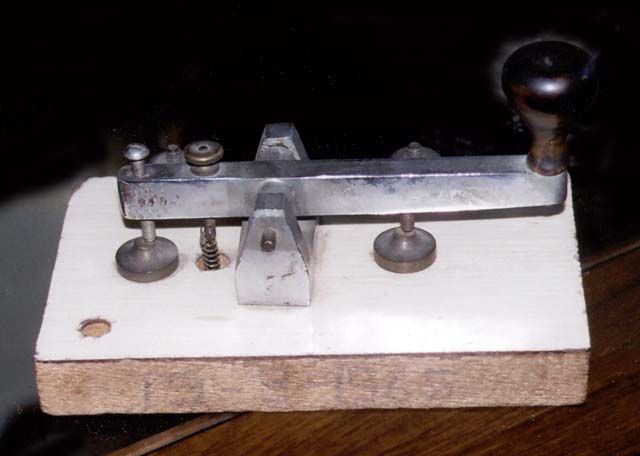
161 * EARLY OTTOMAN EMPIRE TURKISH TELEGRAPH
KEY:(29KB)This early Turkish land-line telegraph key was found
but not purchased in an antique store in Istanbul in 2003. Its basic design
is quite similar to the design of # 160 above.

169 EXTREMELY EARLY GERMAN LAND-LINE
CAMELBACK KEY:(31KB) This is a very early German Camelback key although
the next key in the museum, number 170, is clearly much earlier.

169a Another view of the Camelback
Key:(34KB)

170 EXTREMELY EARLY GERMAN LAND-LINE CAMELBACK
KEY:(14KB) This is one of the very earliest German Camelback keys
that I have ever seen. I believe that it dates to the early 1850's
based on my research in the Siemens and Deutches Museum Archives
in Munich. I believe that the number stamped on the side of the key is
either a part number or the date in which it was placed in service.
I have included several different views of the key.

170a Another view of the Camelback Key:(15KB)

170b Another view of the Camelback Key:(14KB)
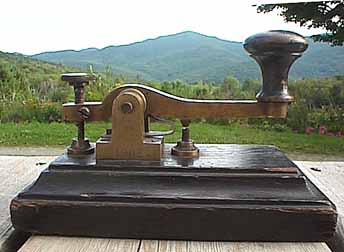
170c Another view of the Camelback Key:(18KB)

170d Another view of the Camelback Key:(27KB)

170aa ANOTHER EXTREMELY EARLY GERMAN LAND-LINE CAMELBACK
KEY:(15KB) This is similar to the one above but perhaps slightly
later.
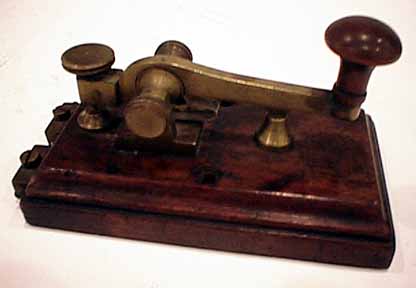
170ab Another view of the extremely early German Camelback
Key:(13KB)

171 * VERY EARLY GERMAN LAND-LINE CAMELBACK KEY:(15KB)
Lovely very early German camelback land-line key with the flat, non-
adjustable spring and the heavy brass camelback lever that was
characteristic of the earliest German telegraph keys.

172 * EARLY GERMAN LAND-LINE CAMELBACK KEY:(19KB)
Nice early German camelback land-line key with the flat, non-
adjustable spring and the heavy brass camelback lever that was
characteristic of early German telegraph keys.

173 * LATER MATCHED GERMAN LAND-LINE
CAMELBACK KEYS:(19KB)
These two keys were mounted side-by-side on a single piece of wood.
The keys are numbered 1 and 2. The heavy camelback levers are
similar to those of early camelback keys but these keys were made
around the turn of the century.

173a A closer view of one of the German
camelback keys:(14KB)

174 EARLY GERMAN LAND-LINE CAMELBACK KEY FROM CZECH
REPUBLIC:(19KB)
Nice early German camelback land-line key with the flat, non-
adjustable spring and the heavy brass camelback lever that was
characteristic of early German telegraph keys. This one was used
in the Czech Republic.
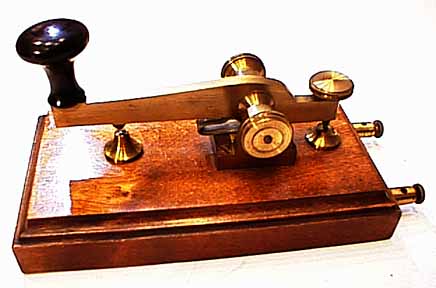
174a Another view of the German/Czech Land line
key:(22KB)

175 VERY EARLY GERMAN LAND-LINE FLAT
SPRING PIVOT KEY:(18KB)
Delicate key with flat spring/pivot (Like a Steiner key) at end of
the 3-3/4" lever. Early Ivory knob and normally open and normally
closed contacts. Books show this to be circa 1840s.

176 VERY EARLY GERMAN LAND-LINE SEMI-CAMELBACK FLAT
SPRING KEY:(34KB)This is an early German land-line key with a very
unusual lever design. It uses the very early flat spring design to hold
the lever up.
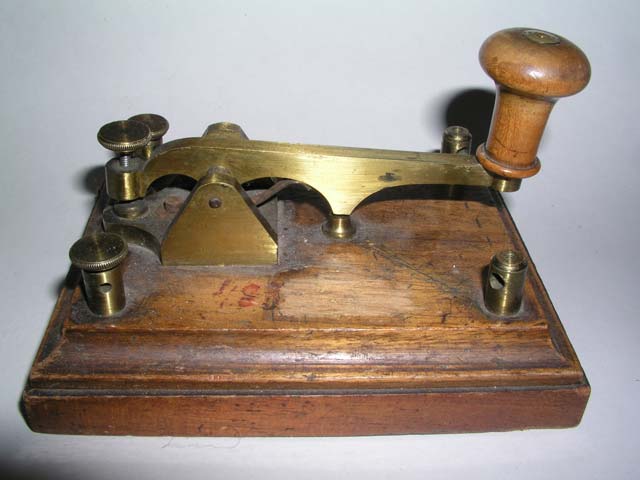
176a Another view of the German key:(36KB)

177 EARLY GERMAN LAND-LINE CAMELBACK KEY:
Nice early German camelback land-line key with the flat, non-
adjustable spring and the heavy brass camelback lever that was
characteristic of early German telegraph keys.
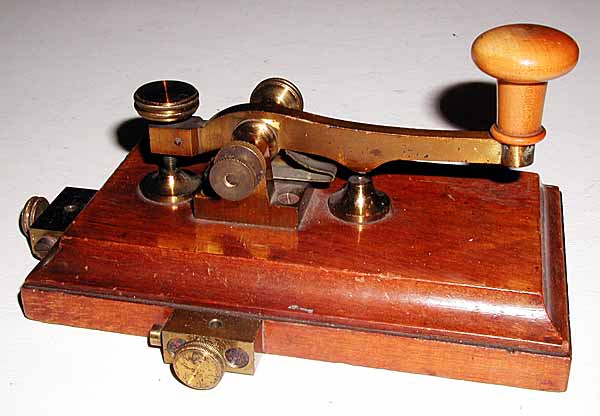
177a Another view of the German Land line
camelback key:
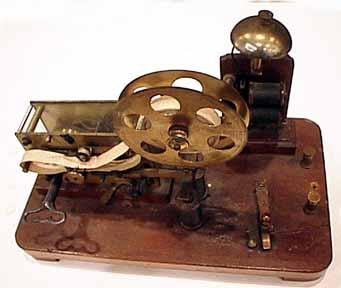
180 * EARLY FRENCH KEY, REGISTER, AND
BELL PRACTICE SET:(17KB)
This is an early French practice set consisting of a small
telegraph key, an electrically operated bell, and a register
which scribed impressions of dots and dashes into a moving
paper tape.

180a Another view of the French practice
set:(16KB)

181 EARLY GERMAN BRASS LEVER CAMELBACK
PRACTICE KEY:(18KB)
Small 3-3/4" brass lever with camelback curve and upward pointing
end leading directly into knob. An early flat spring provides
the tension. This design is typical of most of the early Prussian
land-line keys. These keys were used with early German telegraph
practice sets as shown below which are the German equivalent of the
American Bunnell Camelback key and sounder practice sets.

182 * EARLY GERMAN TELEGRAPH SET: KEY, REGISTER,
RELAY:(13KB)
This simple practice set is the German equivalent of the American
Bunnell Camelback key and sounder practice sets. The simply-made key
follows the classic lines of the earliest Prussian Camelback keys.
The register is also of very simple design. The paper tape is simply
pulled through the register by hand. The relay, although simply made,
is patterned after the earliest Prussian relays.
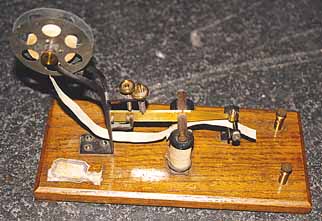
182a * ANOTHER EARLY GERMAN PRACTICE REGISTER:(23KB)
This is another variant of the very simple, hand-operated design.

182b CATALOG ILLUSTRATION OF COMPLETE EARLY GERMAN
PRACTICE SET:(22KB)
This illustration shows a box containing a complete German practice
set consisting of 2 glass batteries, 2 keys, 2 registers, and 2
rolls of wire. The catalog was published in 1910/1911 by
Edmund Prandstatter of Munich, Germany. It is interesting to note
that registers were still being produced and sold at this late date
in Germany while Americans had abandonned registers in favor of
copying code by ear from sounders around the 1860's. It is also
interesting to note that there are NO sounders offered for sale
anywhere in the catalog !!

182c CATALOG ILLUSTRATION OF ANOTHER GERMAN
PRACTICE SET:(15KB)
This practice set from the above catalog included a more complex
spring-driven register which pulled the paper tape automatically.

182d * Another GERMAN PRACTICE REGISTER:(15KB)

182e * Another GERMAN PRACTICE REGISTER:(15KB)

182f * Another GERMAN PRACTICE REGISTER:(15KB)

183 VERY EARLY GERMAN CAST LEVER CAMELBACK KEY:(25KB)
Massive 4-3/4" long cast lever with the classical Prussian
camelback shape. An early flat spring provides the tension.
Normally open contacts only.

185 UNUSUAL EARLY GERMAN CAMELBACK KEY:(15KB)
Small 4-1/4"Camelback lever with unusual upward pointing end leading
directly into knob. Key is pivoted on far end and has coil spring.
Black 3-1/2x2-1/2 base stamped: E.ZIMMERMAN, LEIPZIG. This key was
sold for use in scientific experiments as well as for telegraph.

0187 EARLY GERMAN 'SIEMENS' KEY, REGISTER, & GALVANOMETER
(KROB) SET:(16KB)
This set is a typical example of an early European land-line telegraph system
consisting of a straight-lever German key, an ink writing register,
and a galvanometer for measuring the condition of the line. A roll
of paper tape on which the dots and dashes were written (in ink)
is stored in the drawer under the register.
This set was manufactured by Siemens.

0187a ANOTHER VIEW OF THE SIEMENS SET:(20KB)

0187b ANOTHER VIEW OF THE SIEMENS SET:(17KB)

0188 EARLY FRENCH KEY, REGISTER, & GALVANOMETER
(KROB) SET:(21KB)
This set is a typical example of the early European land-line telegraph
systems which consisted of a straight-lever German-design key,
an ink writing register, and a galvanometer for measuring the
condition of the line. It is called a ''KROB'' set which stands for:
Key and Register on Base. A roll of paper tape on which the dots and
dashes were written (in ink) is stored in the drawer under the register.
This set is stamped with the French manufacturer's name but the
design of the key and register are clearly Siemens.
The name stamped on the set reads: Societe Industrielle des Telephones,
25 Rue du 4 Septembre, Paris. I believe that the set was probably
originally manufactured or certaily licensed by Siemens.
NOTE the interesting telegraph key which has the characteristic
German Siemens spring-mounted lower contacts AND surprisingly, it has
two tension springs. One spring is mounted in front of the trunnion
and one spring is mounted in back of the trunnion. It is unclear
why the spring in back of the trunnion was needed.
The only other two-spring key that I have been able to find is
listed in the Spark and Radio keys' and the 'German Military keys'
sections of this museum.
The following views of this set allow you to see all of the
important details.

0188a Another angled view of the French set:(21KB)

0188b Another angled view of the French set:(22KB)

0188c A view of the French set with paper drawer
open:(19KB)

0188d A close up view of the galvanometer on the French
set:(8KB)

0188e A close up view of the name stamped into the
French set:(12KB)

0188f A close up view of contacts and dual springs of
the (German-origin) telegraph key on the French set:(14KB)
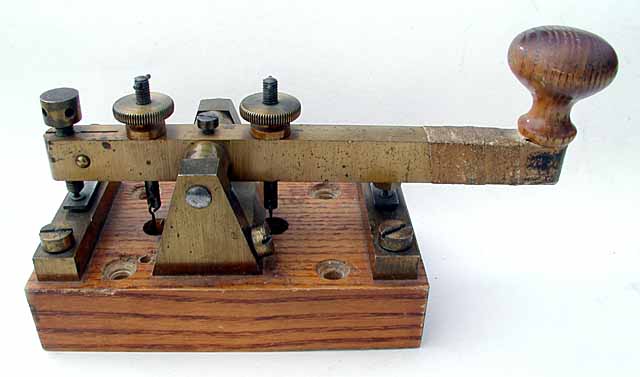
0188g A key that is similar to that
has the same dual springs as those on the above set:(25KB)

0189 * EARLY GERMAN 'WETZER' KEY, REGISTER, & GALVANOMETER
SET:(17KB)
This set is a typical example of a land-line telegraph system
consisting of a straight-lever German key, an ink writing register,
and a galvanometer for measuring the condition of the line. This
one is somewhat later than number 0187 and the black meters were
probably added later than it's first date of manufacture. It
was manufactured by H. Wetzer, Pfronten Bayern.

0189a Another view of the wetzer set:(17KB)

0189b Another view of the wetzer set:(17KB)

0189c Another view of the wetzer set:(18KB)

0189d Another view of the wetzer set:(17KB)

190 LARGE WESTERN UNION TRANSATLANTIC CABLE KEY:(51KB)
Two large old brass levers mounted on a 4-1/2x6" black rubber base.
The left lever was used to send dots. Pressing it drove the cable
voltage positive. The right lever was used to send dashes and drove
the cable negative. Since the cable was thousands of miles long,
it acted as a huge capacitor and the full plus-to-minus voltage was
necessary to help it discharge. The messages were recorded on a
moving paper strip and it took skill to visually tell the difference
between dots & dashes.

0190a Another view of the WU Cable Key:(37KB)
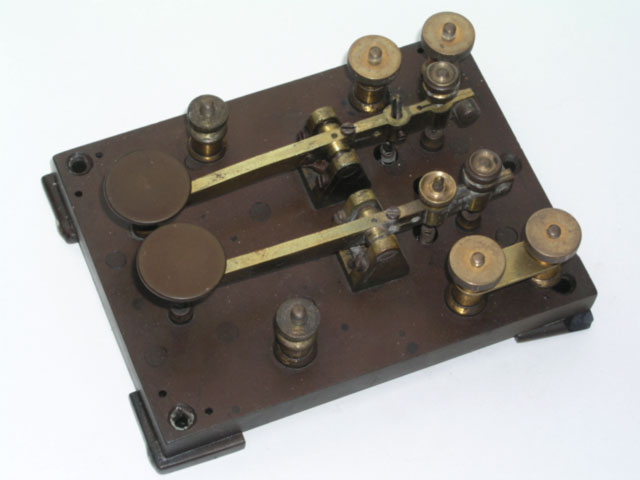
0190b Another view of the WU Cable Key:(37KB)

0190c Another view of the WU Cable Key:(37KB)

0190d A view of the bottom of the base of the
WU Cable Key:(37KB)
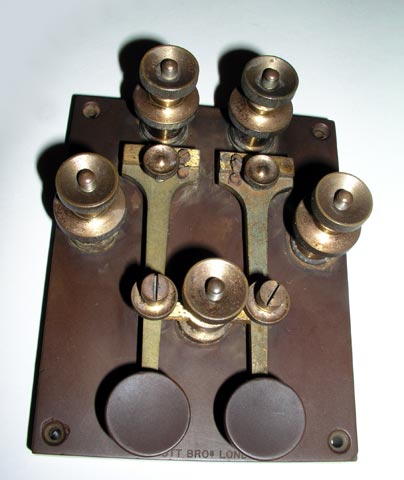
192 LARGE ELLIOTT BROTHERS TRANSATLANTIC CABLE
KEY:(51KB)This is a very fine example of an early submarine cable key. It
has survived in very good condition and shows a plethora of adjustments that
allow it to be set to the exact tension and spacing desired by an operator.
The left lever was used to send dots. Pressing it drove the cable voltage
positive. The right lever was used to send dashes and drove the cable
negative. Since the cable was thousands of miles long, it acted as a huge
capacitor and the full plus-to-minus voltage was necessary to help it
discharge. The cable messages were usually recorded on a moving paper strip
and it took skill to visually tell the difference between dots & dashes.
This key, however, was used with the super-sensitive relay shown below
instead of the typical paper tape recorder.

192a Another view of the Elliott Brothers Cable key:
(41KB)

192b Another view of the Elliott Brothers Cable key:
(41KB)

192c Another view of the Elliott Brothers Cable key:
(41KB)

192d Another view of the Elliott Brothers Cable key:
(41KB)

192e Another view of the Elliott Brothers Cable key:
(41KB)

192f A close view of the Victor-Patent-like pivots on
the Elliott Brothers Cable key: (41KB)

192g A close view of the maker's name on the Elliott
Brothers Cable key: (41KB)

192h The underside of the base of the Elliott Brothers
Cable key: (41KB)

193 SUPER-SENSITIVE POLAR RELAY USED IN SUBMARINE
TELEGRAPH CABLE LINES:(70KB)The electrical signals on a submarine
telegraph cable were usually recorded on a moving paper tape and then
translated into letters by eye. This relay has the extremely high resistance
of 506 Ohms, making it sensitive enough to detect the very small voltage
changes in a submarine cable. In addition, it has numerous very fine
adjustments that allow it to be set to react to very weak signals such as
thouse received over very long cables. There is some engraved writing on the
top of the relay but I have been unable to read it because it is not engraved
deeply enough into the metal. This relay was located along with the
Elliott Brothers Submarine Telegraph Cable Key shown above and was probably
also made by Elliott Brothers.
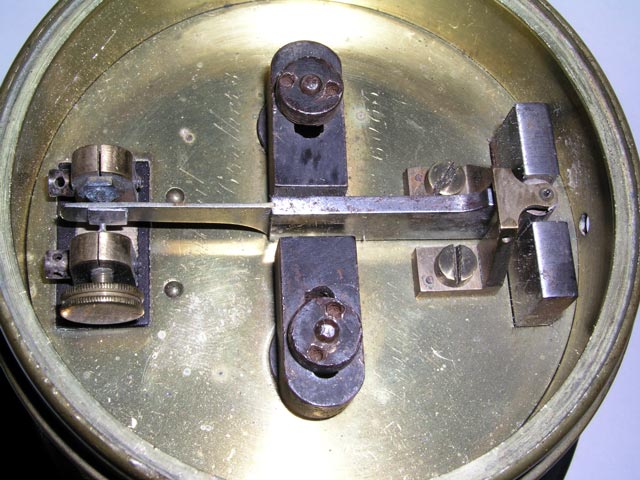
193a A close view of the contacts on the super-sensitive
submarine telegraph cable relay:(50KB)

193b A close view of the sensitive magnets underneath the
submarine telegraph cable relay:(50KB)

193c Another view of the submarine telegraph cable
relay:(50KB)

200 UNUSUAL ELLIOTT BROTHERS "UNIGRAPH"
POCKET KEY AND SOUNDER: (20KB)
This tiny set is carried in a small leather case. It consists of a
2 inch diameter brass cylinder 1-1/2 inch high. A tiny key protrudes
from the side.
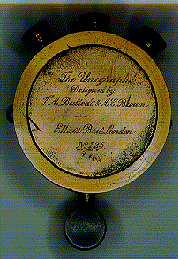
200a The circular disk (24KB) on the
top pivots forward to make a clicking sound when the
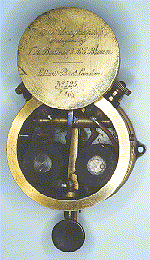
200b coils (22KB) are activated.

200c The top is engraved (30KB):
The "Unigraph" Designed by
T. A. Bullock and A. C. Brown Elliott Bros., London. No 125.

201 * UNUSUAL MINIATURE BRITISH STRAIGHT LEVER KEY: (13KB)
This miniature key was probably made by Elliott Brothers.

201a Closer view of the miniature British straight key:
(14KB)

201b Another closer view of the miniature British
straight key: (12KB)

203 WESTERN ELECTRIC LINEMAN'S POCKET TEST SET:(27KB)
Similar to #205 but tiny camelback-style key has lever stamped
Western Electric Co. Chicago.

203a Another view of W.E. pocket set:(24KB)

205 TILLOTSON LINEMAN'S POCKET TEST SET:(50KB)
These hard-to-find sets were used by early linesmen and Civil War telegraph
operators and spies to carry to the top of telegraph poles & tap into the
telegraph lines for testing, espionage, and sending/receiving messages.
Consists of a lovely oval hard rubber case with engraved top 4-1/2" long by
2" wide. Inside is a tiny key with 1-1/2" lever and a sounder with sensitive
horizontally mounted coils.

205a Another View of the Pocket Set:(53KB)

205b Key End View of the Pocket Set:(36KB)

205c Sounder End View of the Pocket Set:(38KB)

205d Pocket Set and Sharps 4-barrel pistol in Civil War
espionage setting:(56)

206 BUNNELL LINEMAN'S POCKET TEST SET:(34KB)
Tiny sounder integrated with tiny key on black base.

210 POSTAL TELEGRAPH COMPANY POCKET TEST
SET:(13KB) This very small set was made by The Postal Telegraph
Company and used by the military in the Spanish-American war and others.

210a Opening the cover reveals the key
mechanism:(13KB) and the sounder armiture.

210b The removal of the entire front cover:(12KB)
shows the coils for the sounder and the "Skirrow patented"
rack-and-pinnion device that adjusts the coil-to-armiture distance.

212 COMPLETE PORTABLE WESTERN UNION TELEGRAPH
OFFICE:(17KB) This is a complete portable 1870's Telegraph office.
It is contained in a special box which serves as a desk and which can
be attached to a telegraph pole.
It was carried in a railroad car and used for emergency communications
along the railroad line. This is a very interesting set so I have included
many different views of it and it's components. Several views are
very similar to each other but have slightly different color balance.
As you can see, the set can be attached to any convenient telegraph
pole using a chain attached to the back of the cabinet.
It can be electrically hooked into any telegraph line using the
special connector called a 'Wrecking Clamp'. A blueprint shows the
wiring of many of the telegraph poles along the railroad line so the
telegraph operator can know which line to tap into.
The following views and descriptions should explain the operation
of this unusual set...
Very similar portable telegraph offices were carried in Fire Chiefs'
buggies in major city fire departments to allow communications during major
fires. A pole-mounted tent was often used to protect the equipment and
telegrapher from the elements in bad weather.

0212a A similar but slightly closer view of the set
with an operator:(18KB)
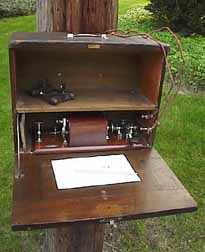
0212b A view of the front of the set without the
operator:(14KB)

0212c A similar view of the front of the set without
the operator:(15KB)

0212d A view of the back of the set showing how
it is chained to the telegraph pole:(23KB)

0212e A view of the front of the set with the
cover/desk closed:(11KB)

0212f A view of the back of the set showing the
wooden saddles and the chain for mounting the set to the telegraph pole:
(11KB)

0212g A view of the front of the set with the cover/desk
open:(11KB)

0212h A different view of the front of the set with the cover/desk
open:(11KB)

0212i A closer view of the front of the set with
the cover/desk open:(17KB)

0212j A still closer view of the front of the set with
the cover/desk open:(19KB)

0212k A view of the blueprint showing the wiring of
the different telegraph poles along the various sections of track:
(10KB)
0212kl A MUCH higher resolution view of the blueprint:
NOTE This is a BIG, SLOW-LOADING 135KB file! :(135KB)
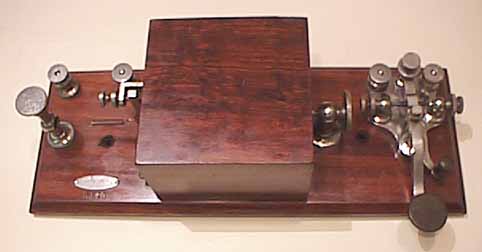
0212l The sensitive Western Union Box Relay
Key and Sounder with the magnificent Lewis key:(14KB)

0212m The lovely Lewis telegraph key:(15KB)
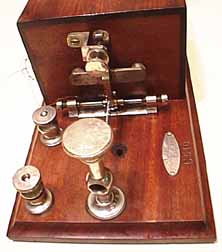
0212n The adjustments for the sensitive sounder
part of the instrument:(14KB)

0212o The label on the telegraph set reads:
''PATENTED OCT. 12, 1871, W.U.TEL CO'' and number C540 is stamped
into the wood:(16KB)

0212p The ''Wrecking Clamp''. This clamp was
tightened over a telegraph wire and then the wire was cut. The
terminals on the clamp allowed electrical connections to be made
to each of the severed ends and the switch on the clamp allowed
the two severed ends to be electrically reconnected:(12KB)

217 * VERY SMALL EARLY BRASS LEG KEY:(15KB)
A tiny brass leg key with heavy lever and pressed-in steel trunnion.

218 VERY SMALL EARLY NICKEL-PLATED BRASS LEG KEY:(43KB)
A tiny nickel-plated brass leg key with a heavy lever and a
pressed-in steel trunnion.

218a Another view of the tiny key:(33KB)

218b Another view of the tiny key:(32KB)

218c A view of bottom of the tiny key:(30KB)

215 Another similar tiny key:(16KB)

215a Another view of the tiny key:(16KB)

220 GRAY & BARTON LEG KEY:(24KB)
Lovely very early square brass lever bent down slightly toward knob
and stamped "GRAY & BARTON, CHICAGO". Trunnion is nicely machined
steel held in place by a setscrew. Very early design with no spring
adjusting screw (a refinement invented by Phelps in the 1860s). Short
brass shorting lever pivoted under trunnion. Cast brass base stamped
"828". 2 tapered SMOOTH brass legs extend down 2" & end in brass-screw
wire binding posts. ca. 1860s.

221 R. HENNING "MAKER" SOUNDER:(38KB)
Very early all brass sounder used with 220 above. armiture stamped
R.HENNING, MAKER on side & W.U.TEL.CO on top. Very early design.
221a * R. HENNING "MAKER" SOUNDER: As above. Traded to Roger Reinke.
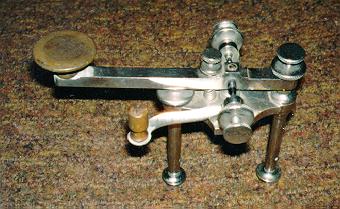
222 Western Union / Grey & Barton Key:(24KB)
Same as 220 with Nickel-plated lever, unstamped,base stamped"416".
Spring adj screw. ca. 1860s.

223 * JAMES PARTRICK BRASS KEY AND SOUNDER:(24KB)
Lovely and delicate all brass key similar in design to #110 with
matching sounder >K9WDY

224 PARTRICK & CARTER "ARCH" KEY & SOUNDER:(47KB)
This large set has an extremely unusual

224a Partrick & Carter step-lever
key with a lovely brass arch over the
trunnion:(55KB).

224b This view shows the front of the key:(22KB)

225 BRASS STEP-LEVER KEY & SOUNDER ON WOODEN BASE:(32KB)
Masive brass lever key with steel shaft, japanned base, and early
step-down lever design on wooden base with Black Japanned base sounder
with gold lettering "PATENTED FERY 16,1875".

225a CLOSE-UP OF BRASS STEP-LEVER KEY:(16KB)

227 CLASSIC LEWIS PATENT KEY: (36KB)
This is one of the more frequently seen versions of the Lewis Key
which is the only key that was granted a patent exclusively based on
the beautiful design of the key rather than any innovative electrical
or mechanical attributes.

227a Another view of the LEWIS KEY: (36KB)

228 VERY UNUSUAL FLAT-LEVER LEWIS PATENT KEY: (33KB)
This is one of the most unusual Lewis keys. It has a flat steel lever
instead of a nickel-plated brass lever and the pivot points are at the
far end of the lever.

229 MINIATURE LEWIS KEY BOX RELAY/SOUNDER: (38KB)
This is an unusually small so-called box relay with a boxed sounder/relay and a
lewis key on a wooden base. It is not clear why it was made in such a small
size.

229a A closer view of the key: (37KB)

229b A closer view of the relay/sounder: (44KB)

230 LEWIS / WESTERN UNION TELEGRAPH SET:(25KB)
This unusual set consists of a lovely brass LEWIS key mounted
perpendicularly across a 12inch long wooden base which is mounted on a
gold pin striped black cast iron base. To the left of the LEWIS key is
an unusual sounder and to the right of the LEWIS key is a line relay
of unusual design. The adjusting string/spring for the relay passes
over the top of the LEWIS key from right to left to an adjusting knob.
The relay is engraved W.U. TEL. CO. on the brass base and OHMS 153 on
one brown coil cover. The key is engraved "LEWIS PAT May 25, 1875 May
23, 1876 on top of the lever and "W. E. MFG. CO. CHICAGO" on the side
of the lever. Bottom of base signed in ink: J.F. Putnam, July 10/80.

230a Another View of the Lewis/WU Set:(47KB)

232 EXTREMELY UNUSUAL STRAIGHT LEVER FLAT TERMINAL LEWIS
KEY:(16KB) This is the strangest Lewis Key that I have ever seen.
The lever is nearly straight which is unusual for Lewis keys but
the most unusual aspect of the key is the three flat-topped terminals
which, as you can see from the underside view connect to the
normally open, normally closed, and frame of the key.
There is no way to connect wires to these terminals directly so
I can only assume that the key was slid into some sort of spring
loaded contact assembly. I have included several different views
of the key.

232a Another view of the Flat Terminal Lewis
Key:(15KB)

232b Another view of the Flat Terminal Lewis
Key:(25KB)

232c A view of the bottom electrical connections
of the Flat Terminal Lewis Key:(18KB)

233 ** EXTREMELY UNUSUAL LEWIS CAMELBACK
KEY:(21KB) This is a very unusual Lewis patent key with a
camelback lever. Most Lewis keys have a gently sloping lever
which paved the way for virtually all subsequent key designs.
This key is owned by collector: Gray Marshall KQ6MW..
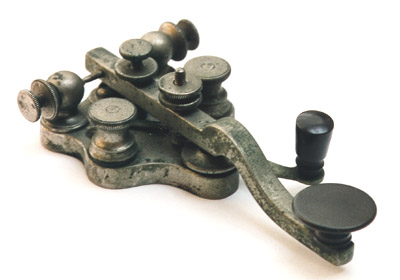
233a * ANOTHER VIEW OF THE CAMELBACK LEWIS
KEY:(21KB)

234 LEWIS KEY: (15KB)
This is one of the more frequently seen versions of the Lewis Key.
It is described more fully in the write-up of the key below.

234a Another view of the LEWIS KEY: (16KB)

235 LEWIS KEY: (78KB)
This all-plated Lewis key is an example of the early Lewis designs
which did not include adjustments for side-play in the trunnion. The
Lewis key patents referred to the unique and ornate design of the key rather
than any distinguishing mechanical attributes. Stamped: LEWIS PAT.
May 25, 1875, May 23, 1876 on top of lever and W.E.MFG CO. Chicago on
side of lever..
ROTATING VIEW OF #235 LEWIS KEY: (202KB)
This is a VERY LARGE FILE that takes a long time to load but
it results in a view of a rotating Lewis Key. It is an experiment
to see whether it would be a practical way to show many sides
of the same key.
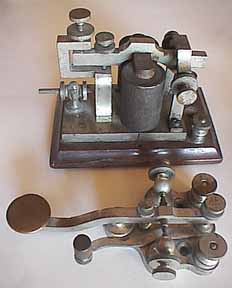
236 RAILROAD LEWIS KEY AND LEWIS CAMELBACK
SOUNDER:(14KB) This is a classic Lewis Key with an unusual
Lewis Camelback Sounder. The Key and Sounder were apparently
used on the railroad because each is marked NPRR. The key is marked
J-165 and the Sounder is marked J-166. I have included several
different views of the set.

236a A closer view of the Lewis Key:(11KB)

236b A closer view of the markings on the
Lewis Key:(9KB)

236c A closer view of the markings on the3
Camelback Lewis Sounder:(18KB)

237 LEWIS KEY AND SOUNDER:(16KB)
Lewis key like 0235 with hard-to-find Lewis sounder.
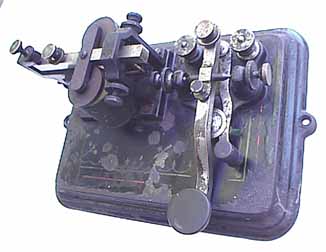
238 * LEWIS KEY AND SOUNDER 'PRIVATE LINE' CAST-BASE KOB
:(16KB) This Lewis Key and Sounder have their bases cast into
the cast iron base of this 'private line set'. Private line sets such
as this were used in private residences and in businesses to
communicate within the bruiding. (Same as item 275.)

238a Closer view of the cast-base Lewis
Key:(16KB)

239 LEWIS KEY KOB:(17KB) This is an
all brass Lewis Key mounted on a wooden base with an early
horizontal spring sounder.

239a Another View of the LEWIS KEY KOB:(41KB)

240 EARLY LYMAN PATENT KEY: (19KB)
This key shows the unique Lyman patent design with the lever suspended by a
"y" shaped piece of spring steel.

240a Another view of the EARLY LYMAN KEY: (19KB)

240e UNUSUAL AND EARLY NICKEL PLATED LYMAN PATENT
KEY:(26KB)
This is the first Nickel plated Lyman key that I have seen. It shows the
unique Lyman patent design with the lever suspended by a "y" shaped piece of
spring steel.
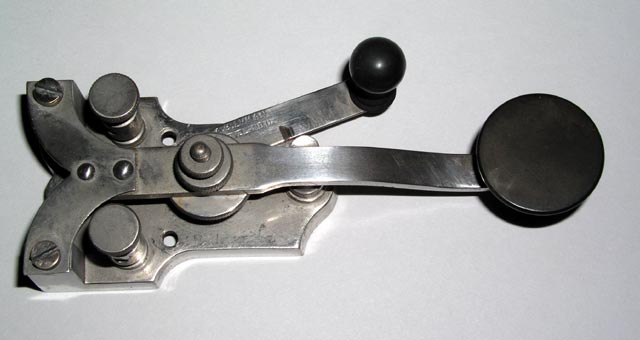
240f Another view of the Nickel Plated Lyman
Key:(28KB)

240g Another view of the Nickel Plated Lyman
Key:(30KB)

240h Another view of the Nickel Plated Lyman
Key:(25KB)

240i A view of the bottom of the Nickel Plated Lyman
Key:(31KB)
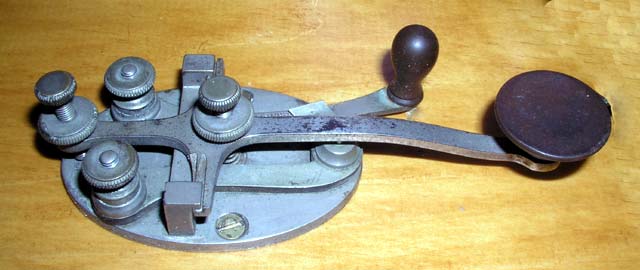
241 EARLY NICKEL-PLATED VICTOR PATENT LEGLESS KEY:(27KB)
This lovely nickel-plated brass key shows the "Victor patent" knife-edge
bearings. Rather than using a pinnion shaft, the key pivots on a knife-
edge.

241a A slightly different view of the Victor
Key:(30KB)

243 * VICTOR PATENT LEG KEY:(17KB)
This lovely brass key shows the "Victor patent" knife-edge bearings.
Rather than a pinnion shaft, the key pivots on a knife-edge.
The legs attach the key to the operating table and also
provide connections for the electrical wires.

243a Close-up view of Knife-edge pivot:(24KB)

245 * TILLOTSON KOB WITH TILLOTSON-VICTOR KEY:(17KB)
This lovely brass key shows the "Victor patent" knife-edge bearings.
It is stamped: Pats Dec 26, 1882. Both are stamped: L.G.Tillotson,
5 & 7 Dey St. New York. The base is stamped:
20 Ohms, L.C.T. & co. 8 Dey St.,N.Y.

248 * TILLOTSON CAMELBACK KOB:(15KB)
This is a nice example of a Tillotson Camelback KOB.
I have included several different views of the set.

248a Another view of the Tillotson Camelback
KOB:(15KB)

248b Another view of the Tillotson Camelback
KOB:(14KB)

250 GREELEY / TILLOTSON CAST-LEVER CAMELBACK KOB:(43KB)
'KOB' stands for 'Key (and sounder) on base'.
Gold-painted early camelback key with cast iron lever, shorting switch
& matching sounder on wooden base which is engraved E.S.GREELEY & Co.
Successors to L.G.TILLOTSON & Co. New York.
Too early for spring adjusting screws.

250aa GREELEY / TILLOTSON BRASS-LEVER CAMELBACK
KOB:(41KB)Early camelback key with brass lever, shorting switch
& matching sounder on wooden base which is engraved E.S.GREELEY & Co.
Successors to L.G.TILLOTSON & Co. New York.
Too early for spring adjusting screws.

251 * BUNNELL CAST-LEVER CAMELBACK KOB:(40KB)
Made by Bunnell around 1860s. Cast-Iron Lever Camelback Key originally
painted gold to look like brass. Like number 250 above on unmarked base.

252a * BUNNELL CAST-LEVER CAMELBACK KOB:(27KB)
As above on base stamped 20 ohms. J. H. Bunnell.

254 BUNNELL CAMELBACK KOB:(42KB)
Made by Bunnell around 1860s. Like 252a above with black-painted
camelback key mounted on unmarked base. The
sounder is mounted on a large thin brass plate. An interesting
spring-adjusting screw was added by a railroad operator in 1945.

259 * MINIATURE CAMELBACK KOB:(50KB)
About 3/4 size mini cast-iron-lever camelback key & small sounder on
wooden base. No identification but all painted black with fine gold
flower patterns on key & sounder.Too early for spring adj screw.

260 BUNNELL BRASS-LEVER CAMELBACK KOB:(73KB)
Early brass lever camelback key with steel trunnion and shorting
switch and black and gold painted sounder on wood base stamped
20 Ohms, J.H.Bunnell & Co., New York.

260aa BUNNELL BRASS-LEVER CAMELBACK KOB:(43KB)
Similar to 260 above:

261 BUNNELL BRASS-LEVER CAMELBACK KOB:(44KB)
Early brass lever camelback key with steel trunnion and shorting
switch and black and gold painted sounder on unmarked wood base.

261aa * Another BUNNELL BRASS-LEVER CAMELBACK KOB:(47KB)
Similar to above. This key is now on display in the National Cryptological
Museum of the NSA in Baltimore, MD.:

261b * The Bunnell Brass-Lever Camelback KOB as it
appears in the NSA National Cryptological Museum:(80KB)
262 * REDDING BRASS-LEVER CAMELBACK KEY KOB with brass-Lever key, on a
cast iron oval base frame with a shorting switch. Key has spring
adjusting screw. Mounted on wooden base which is engraved
JEROME REDDING & Co BOSTON, MASS - 4 ohms Pat
April 3D '77. Small piece of base back missing.>>W2PM
264 * REDDING BRASS-LEVER CAMELBACK KEY KOB. As above.
No patent date or shorting switch.

266 EARLY UNKNOWN BRASS-LEVER CAMELBACK-KEY KOB:(41KB)
Brass-lever camelback key with steel trunnion shaft, no spring adjusting screw,
& brass shorting lever. All cast iron sounder. Both key and sounder have
unusual bulges where trunnion shafts pass through. This is probably
a Redding as above.

270 EARLY CAST-BASE TILLOTSON STRAIGHT-LEVER KEY
PRIVATE-LINE KOB:(47KB)This private line KOB has a brass Key with
a straight brass lever, steel trunnion shaft, spring adjusting
screw, and brass shorting lever. The base is very heavy cast iron with
a sounder stamped "BUNNELLS PATENT JULY 1874 No737" on the heavy brass
armiture. These sets were often used in private residences in the 1870's.

270a Another view of the Private Line KOB:(44KB)

270b A closer view of the Bunnell Patent
notice:(35KB)

270.gif Another view of the Private Line KOB:(53KB)

271 * CAST-BASE WESTERN ELECTRIC PRIVATE-LINE KOB:(23KB>
Black cast-iron base with the Western Electric key that has two
parallel rods as its lever.

271#2 CAST-BASE WESTERN ELECTRIC PRIVATE-LINE
KOB:(20KB)Identical to number 271.

272 VERY EARLY L.G.TILLOTSON ALL
BRASS KEY AND "APRIL-FOOL" SOUNDER KOB:(59KB)
The key is a straight brass lever stamped L.G.TILLOTSON, 8 Dey St.,
New York. with no spring adjusting screw and a steel trunnion The
sounder has two coils in line from front to back but the armiture is
pivoted at the top center of one of the coils which can't possibly
make any contribution to the operation of the sounder. (Did they not
know this?) Sounder armiture stamped Patent App'd For. Wooden base
stamped 6 Ohms, L.G.T. & Co. 8 Dey St. N.Y. Patented June 24, 1873.

273 ** VERY EARLY L.G.TILLOTSON ALL
BRASS KEY AND REDESIGNED SOUNDER KOB:(46KB)This
set appears to have been designed after Tillotson realized
the error in the design of the ''April-Fool'' sounder shown
above in item 272. The sounder now has both of the magnet coils
pulling on the armiture. This set is labeled BLISS TILLOTSON and
a pencilled-in address on the bottom shows that it was manufactured
at 54 South 4th Street in Philadelphia where the company moved
in 1874 which was the year after the above set was patented.

273a ** Closer views of the key and
name:(51KB)
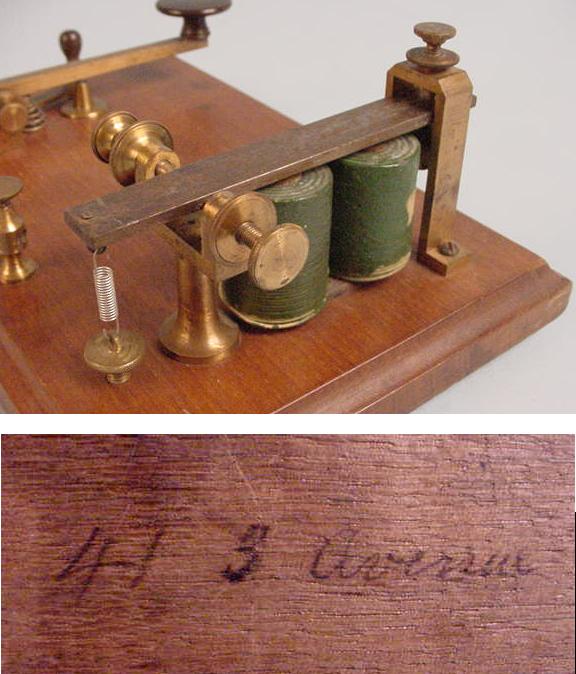
273b ** Closer view of the sounder and
address:(60KB)

274 UNUSUAL ROUND TRUNNION FRAME KOB:(34KB)
This is a very unusual early KOB with both the sounder and
the key frame designed as circles. The maker is not known.
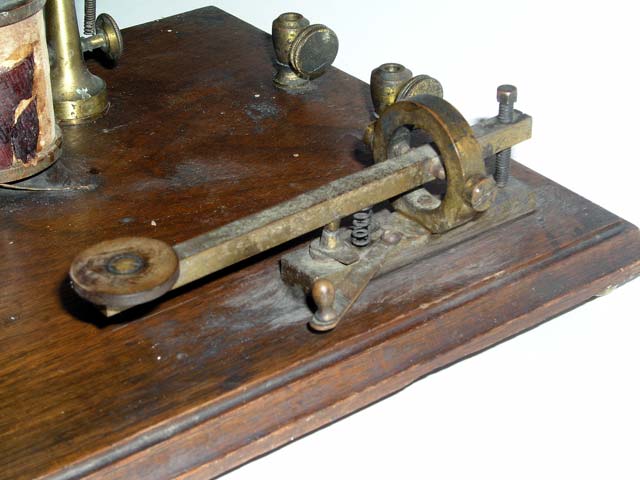
274a A Close view of the tiny key:(44KB)

274b A Close view of the sounder:(45KB)

274c Another view of the KOB:(27KB)
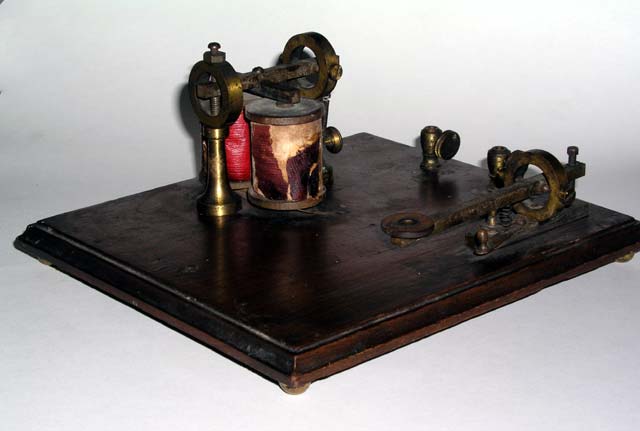
274d Another view of the KOB:(27KB)
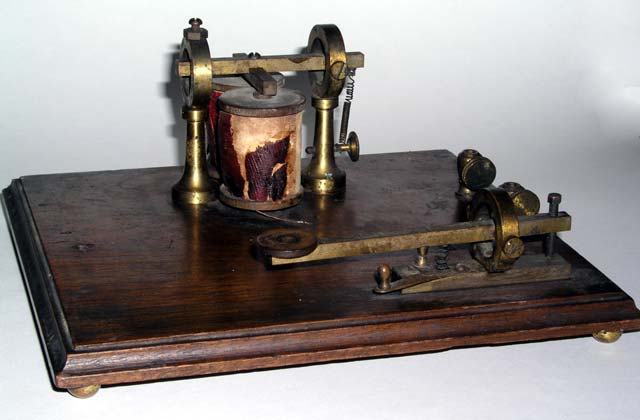
274e Another view of the KOB:(33KB)

274f A View of the underside of the base:(39KB)

275 * CAST-BASE LEWIS KEY PRIVATE-LINE KOB:(21KB)
This set has a Lewis-patent key and a Lewis sounder with their bases
cast as integral parts of the large cast iron base. The lever of the
key is stamped: Lewis Pat. May 28, 1875, May 26, 1876 on top and
Western Electric Co. Chicago on the side. (Same as item 238.).

275a Closer view of Lewis Key:(21KB)

278 * VERY EARLY CHARLES WILLIAMS (Boston)
CAMELBACK KEY: This is a fine example of the camelback keys made
by Charles Williams in Boston. This camelback key was probably made after
the next two Williams keys.

278a * The other side of the Williams key:

279 VERY EARLY CHARLES WILLIAMS (Boston) KEY:(30KB)
Early brass straight lever key mounted on a wooden base with the Williams
name stamped into the base.

279a Another View of the Williams Key:(29KB)
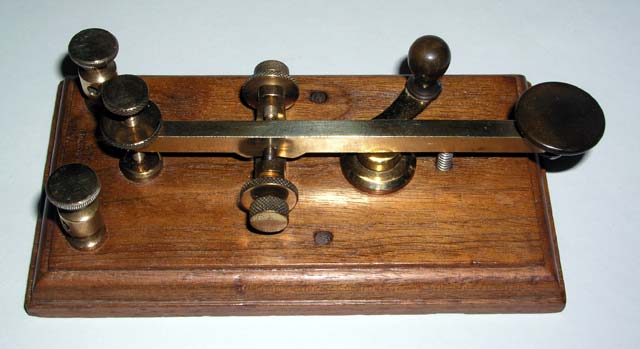
279b Another View of the Williams Key:(32KB)

279c Another View of the Williams Key:(23KB)

279d Another View of the Williams Key with the lever
removed:(48KB)

279e A view of the name stamped into the base of the
Williams Key:(51KB)
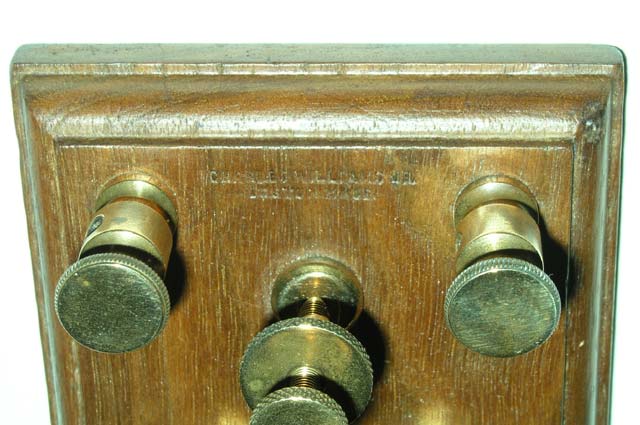
279f A view of the name stamped into the base of the
Williams Key:(50KB)

279g A view of the bottom of the base of the
Williams Key:(50KB)

280 * VERY EARLY CHARLES WILLIAMS (Boston)
KEY & SOUNDER:(36KB)
Early brass straight lever key and extremely early sounder mounted on
a wooden base. Sounder design suggests that it is circa 1850's.
Traded to W2PM

281 VERY EARLY AND UNUSUAL 'PUTT' NON-ELECTRIC
PRACTICE SET:(36KB)This set is very similar to the Charles
Williams Set listed as number 280. It has, however, no electric
mechanism. Pressing down on the key operates a long metal bar hidden
under the base which, in turn, pulls down the sounder. Each time the
key is pressed, therefore, the sounder makes a clicking sound. The
set was used for code practice without the need for batteries.
The wooden base is stamped: PAT'D MAY 31.70 D.W.PUTT & Co.
WELLSVILLE.O

285 VERY EARLY JAMES CLARK (Philadelphia)
CAMELBACK KEY & BOX SOUNDER:(35KB)
Very unusual camelback key with pull-down spring at far end and
Prussian-like upswept lever mounted on wooden base with early
wooden box sounder. Circa 1850s.

285a Closer view of key:(48KB)
This view shows the shape of the lever and placement of the spring.

285b Side view of key showing curvature:(25KB)

285c Another side view showing curvature:(57KB)

298 SOUNDER D'EXERCICE:(56KB)
Unique old miniature wooden resonator on pedistal with wooden key
pivoted at base. Key mechanically connected to a bar which strikes
an anvil inside the resonator making clicking sounds for practicing
sending & receiving. Marked:SOUNDER D'EXERCICE,Alban La FON,EVEREUX.
Signed R.Guillet,PTT twice.

315 BUNNELL NON-ELECTRIC PRACTICE SET:(39KB)
Brass, horizontally-mounted sounder lever with small telegraph key
knob attached directly to it. It was used to provide practice
clicking sounds for people learning the Morse code without the
need for batteries and wiring. Japanned, pinstriped frame on wooden
base. Original box & stamps.

325 BUNNELL ARTICULATED NON-ELECTRIC PRACTICE
SET:(15KB)
Interesting combination of a brass sounder and telegraph key
with a mechanical connection whereby pressing the key causes
the sounder to move downward to make a click. It was used to provide
practice sounds for people learning the Morse code without the need
for batteries and wiring.

325a EARLY BUNNELL LOGO STAMPED INTO BASE:(22KB)

405 KNUDSEN MORSE REGISTER:(62KB)
Made by Cornelius Knudsen in Denmark. - circa 1850 Before it was
discovered that the Morse code could be copied by ear, "Registers"
were used to print the characters on a paper tape for later
transcription. These spring powered Registers continued to be used
because they were thought to be more reliable than sound copy and
because they made a permanent record. This is a very early brass
register with an unusual armiture which presses the paper tape up
against the (missing) pen to mark dots or dashes on the tape in
ink. It has a key wound mechanism (with key) which runs
constantly.

650 * EARLY L.G.TILLOTSON SOUNDER:(17KB)
Early all brass frame with brass armiture stamped
L.G.Tillotson, 8 Dey St. New York with steel trunnion crimped
into brass armiture. Horizontal adjusting spring.
Wooden base. Notice the box-like anvil. It is similar to the
Williams Sounder (Number 280) and the Putt practice set sounder
(Number 281) seen above although those anvils were mounted on
a single upright post.
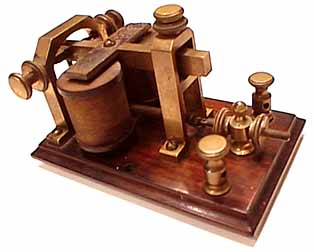
650a A view of the other side of the
sounder:(16KB)
685 * VERY EARLY L.G.TILLOTSON SOUNDER: Very early all brass frame with
brass armiture stamped L.G.Tillotson, 26 Dey St. New York with steel
trunnion crimped into brass armiture. Horizontal adjusting spring.
Wooden base.

690 UNUSUAL VERY EARLY ROUND
L. G. TILLOTSON SOUNDER:(29KB)
Ornate brass design with brass armiture stamped L.G.Tillotson, 8 Dey
St. New York, with steel trunnion crimped into brass. Horizontal
adjusting spring. All mounted on ROUND plated brass base.
691 * VERY EARLY TILLOTSON SOUNDER: Medium size, all-brass sounder in
excellent condition. Armiture is stamped "L.G.TILLOTSON & Co. 5&7 Dey
St. New York." and "Pat'd Feb 16, 1875". Base is also stamped TILLOTSON
and same address.
692 * VERY EARLY TILLOTSON SOUNDER: Similar to above but smaller. Armiture
patent reads "Patent July 1874. No address on base. >Traded out.

693 * UNUSUAL TRANSITIONAL SOUNDER WITH VERTICAL
AND HORIZONTAL SPRINGS:(17KB) This is an interesting sounder
which has parts for both horizontal and vertical springs. Although
the Anvil is broken off, you can see where the horizontal spring
adjusting screw was mounted. You can also see how the vertical spring
was mounted. The transition from horizontal springs to vertical
springs is generally believed to signal a major shift in
sounder design strategy and this sounder appears to incorporate
both designs.

693a Another view of the Transitional Sounder:(16KB)
694 * VERY EARLY GREELEY SOUNDER: All plated. E. S.GREELEY & CO.
5 & 7 Dey St. New York.

740 VERY UNUSUAL SOUNDER-ACTUATOR?:(8KB)
This extremely unusual sounder/Actuator was found at an abandonned
railroad station in the far west. It is of cast iron
construction and looks very early. The sounder mechanism has
an added long lever which allows it to act as an actuator to
perhaps activate another mechanical mechanism.
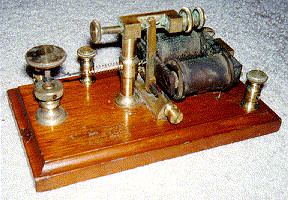
800 * EXTREMELY EARLY TILLOTSON RELAY:(33KB)
This extremely early L.C. Tillotson relay exhibits the early
spring-through-the-post design along with the post-mounted contacts.
These features were abandonned early in the design of relays. It
is stamped L.C.T. & CO. 6 DEY ST. NY. 60 ohms. Circa 1850's. (Traded
to John Casale - W2NI.)

945 VERY EARLY TELEGRAPH PLUG-BOARD:(33KB)
This board was used to connect office telegraph instruments
to 4 telegraph lines. Brass plugs with insulated handles
shorted the blocks together and made the connections.

945a Another view of the plug-board:(33KB)

945b The back of the plub-board:(32KB)
Click Here for Part I:
CONTACT INFORMATION
Please Note: IF YOU DO NOT RECEIVE AN ANSWER TO YOUR EMAIL
IT MEANS THAT I CAN NO LONGER RESPOND.
Please use internet search engines to find other information if you do not receive a reply.
Professor Tom Perera
Ph. D. - W1TP
Professor Emeritus:
Montclair State University
Go to Tom Perera's Professional Neuropsychology Home Page.
- Email Address:
(To help me avoid automated 'junk mail' programs,
I ask you to type my email address as
follows with no spaces between words:)
- PLEASE TYPE: keys
- THEN TYPE THE @ SYMBOL
- THEN TYPE: w1tp.com
- Please NOTE: { it is w1tp - W then the NUMERAL "1" (one) then tp }...
(It is NOT wLtp or wItp).
- Please NOTE: IF YOU DO NOT RECEIVE AN ANSWER TO YOUR EMAIL IT MEANS THAT I CAN NO LONGER RESPOND.
Please use internet search engines to find other information if you do not receive a reply.
- Please NOTE: You MUST include the word
KEYS in the Email Subject Line.
- Please Sign your email.
IF you do not receive a reply my spam cleaner might have intercepted your
email.
Pease try again with a different Subject and Text.
- ( Please Enquire Before Sending Attachments Larger Than 1MB - Thank
you.)
Internet On-Line Telegraph & Scientific Instrument Museums:
http://w1tp.com
Internet ENIGMA Museum:
https://EnigmaMuseum.com
COPYRIGHT NOTICE: (Copyright (c) 2023: Prof. Tom Perera Ph. D.)
Although all the pictures and text are copyrighted, you may use any of them
for your own personal applications including public lectures and
demonstrations, publications and websites as long as you mention the
w1tp.com Museum. If you plan to offer them for sale to the public
in any form, please email me for permission which I will generally grant as
long as you mention my museum: http://w1tp.com or https://EnigmaMuseum.com My email address is
given at the bottom of this page. Some of the material may require contacting
other copyright owners for commercial use and I will inform you by email.
Please also see the Disclaimer of Warranty.































































































































































































































